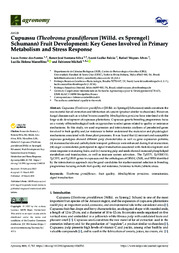Cupuassu (Theobroma grandiflorum [Willd. ex Sprengel] Schumann) fruit development: key genes involved in primary metabolism and stress response.
Cupuassu (Theobroma grandiflorum [Willd. ex Sprengel] Schumann) fruit development: key genes involved in primary metabolism and stress response.
Autoria: SANTOS, L. F. dos; SILVA, R. J. S.; FALCAO, L. L.; ALVES, R. M.; MARCELLINO, L. H.; MICHELI, F.
Resumo: Cupuassu (Theobroma grandiflorum [Willd. ex Sprengel] Schumann) seeds constitute the raw material for oil extraction and fabrication of cupulate (product similar to chocolate). However, fungal diseases such as witches? broom caused by Moniliophthora perniciosa have interfered with the large-scale development of cupuassu plantations. Cupuassu genetic breeding programmes focus on a variety of biotechnological tools or approaches to select genes related to quality or resistance mechanisms. In this study, we used expression and interactomics analyses of preselected genes involved in fruit quality and/or resistance to better understand the molecular and physiological mechanisms associated with these plant processes. It was found that (i) resistant and susceptible cupuassu genotypes showed different pulp characteristics as well as gene expression patterns; (ii) monosaccharide and carbohydrate transport pathways were enhanced during fruit maturation; (iii) sugar accumulation participated in signal transduction associated with fruit development and stress response in maturing fruits; and (iv) maturing pulp and seeds showed increased phospholipid metabolism and translocation, as well as immune system activation. The TgSTP1, TgWRKY33, TgCZF1, and TgUBA1 genes in cupuassu and the orthologues of DIN10, CNI1, and TET8 identified by the interactomics approach may be good candidates for marker-assisted selection in breeding programmes focusing on both fruit quality and resistance/tolerance to biotic/abiotic stress.
Ano de publicação: 2022
Tipo de publicação: Artigo de periódico
Unidade: Embrapa Amazônia Oriental
Palavras-chave: Fruit quality, Interactomics, Moniliophthora perniciosa, Signal transduction, Theobroma Grandiflorum
Observações
1 - Por padrão são exibidas publicações dos últimos 20 anos. Para encontrar publicações mais antigas, configure o filtro ano de publicação, colocando o ano a partir do qual você deseja encontrar publicações. O filtro está na coluna da esquerda na busca acima.
2 - Para ler algumas publicações da Embrapa (apenas as que estão em formato ePub), é necessário ter, no celular ou computador, um desses softwares gratuitos. Sistemas Android: Google Play Livros; IOS: iBooks; Windows e Linux: software Calibre.
Acesse outras publicações
Acesse a Base de Dados da Pesquisa Agropecuária (BDPA) para consultar o acervo completo das bibliotecas da Embrapa.

